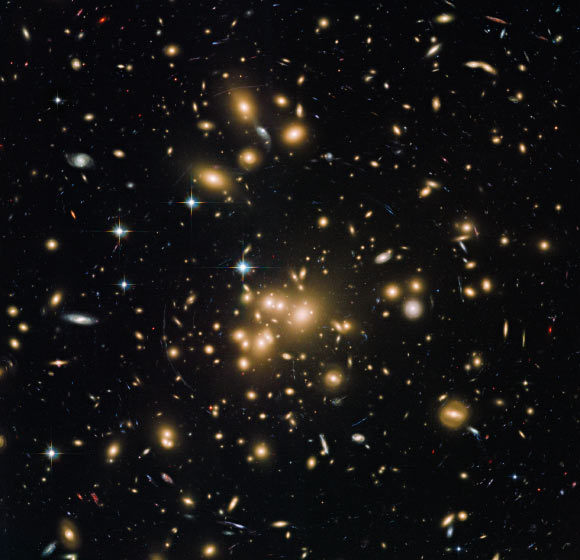
Hubble view of the galaxy cluster Abell 1689. Image credit: NASA / ESA / Hubble Heritage Team / STScI / AURA / J. Blakeslee, Dominion Astrophysical Observatory / H. Ford, JHU.
In the 1990s, two groups of astronomers reported their observations that the expansion of the Universe has been accelerating for the last seven billion years.
Their conclusions were based on analysis of Type Ia supernovae (SN Ia), which are crucial for the studies of stellar evolution, galaxy evolution and cosmology. These objects are known as ‘standard candles’ due to their consistency, allowing astronomers to measure distances in the Universe.
The most widely-accepted theory to explain the accelerating expansion of the Universe is the existence of a strange form of energy called ‘dark energy.’
Now, an Oxford University-led research team has cast doubt on this cosmological concept. Using data from a catalogue of 740 SN Ia, the scientists have found that the evidence for acceleration may be flimsier than previously thought, with the data being consistent with a constant rate of expansion.
“The discovery of the accelerating expansion of the Universe won the Nobel Prize, the Gruber Cosmology Prize, and the Breakthrough Prize in Fundamental Physics,” said senior author Prof. Subir Sarkar, from the University of Oxford, UK, and the Niels Bohr Institute in Copenhagen, Denmark.
“It led to the widespread acceptance of the idea that the Universe is dominated by ‘dark energy’ that behaves like a cosmological constant – this is now the ‘standard model’ of cosmology.”
“However, there now exists a much bigger database of supernovae on which to perform rigorous and detailed statistical analyses,” he said.
Prof. Sarkar and his colleagues analyzed the Joint Lightcurve Analysis catalogue of 740 SN Ia — over 10 times bigger than the original samples on which the discovery claim was based — and found that the evidence for accelerated expansion is, at most, what physicists call ‘3 sigma.’
“This is far short of the ‘5 sigma’ standard required to claim a discovery of fundamental significance,” Prof. Sarkar said.
There is other data available that appears to support the idea of an accelerating Universe, such as information on the Cosmic Microwave Background (CMB) from ESA’s Planck space telescope.
“However, all of these tests are indirect, carried out in the framework of an assumed model, and the CMB is not directly affected by dark energy,” Prof. Sarkar said.
“Actually, there is indeed a subtle effect, the late-integrated Sachs-Wolfe effect, but this has not been convincingly detected.”
“So it is quite possible that we are being misled and that the apparent manifestation of dark energy is a consequence of analysing the data in an oversimplified theoretical model – one that was in fact constructed in the 1930s, long before there was any real data,” he said.
“A more sophisticated theoretical framework accounting for the observation that the Universe is not exactly homogeneous and that its matter content may not behave as an ideal gas – two key assumptions of standard cosmology – may well be able to account for all observations without requiring dark energy.”
“Indeed, vacuum energy is something of which we have absolutely no understanding in fundamental theory.”
“Naturally, a lot of work will be necessary to convince the physics community of this, but our work serves to demonstrate that a key pillar of the standard cosmological model is rather shaky,” Prof. Sarkar concluded.
“Hopefully this will motivate better analyses of cosmological data, as well as inspiring theorists to investigate more nuanced cosmological models.”
The team’s findings were published in the Oct. 21, 2016 issue of the journal Scientific Reports.
_____
J.T. Nielsen et al. 2016. Marginal evidence for cosmic acceleration from Type Ia supernovae. Sci. Rep. 6, 35596; doi: 10.1038/srep35596







